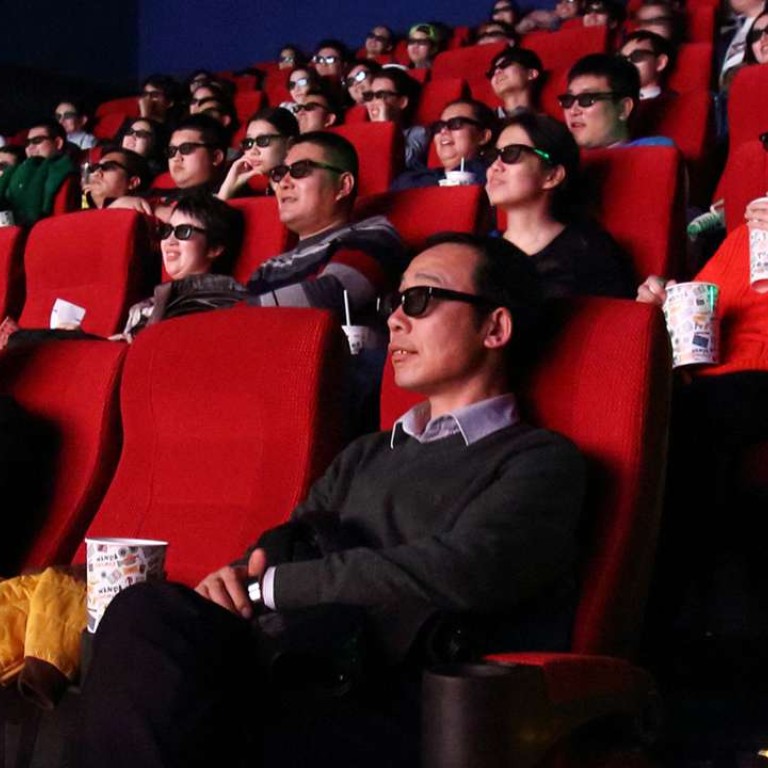
China’s box office to get back on track thanks to subsidies, more screens in smaller cities
Cinemas rake in a record 3.35 billion yuan during the Lunar New Year holiday, beating market expectations
China’s cinemas got off to a strong start in the Year of the Rooster, with box office sales up 10 per cent to a record high during the Lunar New Year holiday, according to official data.
The impressive performance was partially driven by a return of ticket subsidies offered by film distributors and online agencies, industry experts say.
Some analysts expect China’s box office revenue to resume strong growth after a sluggish 2016, as an increasing number of screens in smaller cities will help foster an active film-going culture among the mainland’s vast population.
Gross box office revenue for the Lunar New Year holiday, from January 27 to February 2, hit a new all-time high of 3.35 billion yuan, according to statistics from the General Administration of Press and Publication, China’s state film regulator. That was up 10 per cent from the same period in 2016, when cinemas raked in a 3.05 billion yuan, a record at the time.
Strong CNY [Lunar New Year] box office revenue signals a turning point for China’s film industry
The latest figures took many industry watchers by surprise, after the country’s box office recently posted the weakest annual growth in a decade..
Some observers are interpreting the better-than-estimated performance as a signal that China’s film market has bottomed.
“We forecast 16 per cent box office growth year-on-year for 2017, with 21 per cent growth for Hollywood movies and 12 per cent growth for Chinese language movies,” said Tallan Zhou and Karen Tang, analysts at Deutsche Bank, in a recent research note.
They believe monthly box office growth could start to rebound strongly from March, as a handful of well-known Hollywood blockbusters such as Wolverine 3, Fast and Furious 8, and King Arthur: legend of the sword come to the big screen.
“We have confidence in the growth momentum of China’s movie industry in the long term and expect box office revenue to reach 81 billion yuan by 2020,” said Zhou and Tang.
Ticket sales at IMAX theatres could surge 45 per cent year-on-year, they said.
Analysts from HSBC were a little more bullish, forecasting a 20 per cent increase in ticket revenues this year.
“Strong CNY [Lunar New Year] box office revenue signals a turning point for China’s film industry,” said HSBC analysts John Liu, Chi Tsang, and Wayne Wang in a separate report.
They acknowledged the momentum was in part being driven by a return of ticket subsidies by film distributors and online agencies, estimating that these subsidies reached 1 billion yuan during the Lunar New Year holiday.
“Box office receipts in China are highly correlated with ticket subsidies,” they said.
In 2015, box office revenue rose 50 per cent, as the industry handed out 4 billion yuan of ticket subsidies. Last year’s takings grew just 4 per cent as ticket subsidies fell to 1.5 billion yuan.
But there are other important drivers likely to fuel a resumption of strong growth in 2017, the HSBC analysts said.
We forecast 16 per cent box office growth year-on-year for 2017, with 21 per cent growth for Hollywood movies and 12 per cent growth for Chinese language movies
Firstly, a new industry reporting policy, which allows all third-party online booking fees to be included in overall box office sales, starting in January 2017, may contribute an extra 5 to 7 per cent to box office revenue growth.
More importantly, they said, ticket sales in less developed tier-3 to tier-5 cities could drive growth this year.
The central government has ranked the country’s more than 600 cities by tier according to population, personal income and economic development. The mainland’s four biggest cities of Shanghai, Beijing, Guangzhou, and Shenzhen were placed in tier 1, more than 20 cities were categorised as tier 2, while the rest were ranked between tiers 3 and 5.
During the first five days of the Lunar New Year holiday period, box office revenue in “tier 3-5 cities” climbed 14 per cent from the same period last year, outpacing a 4 per cent year-on-year increase in tier-2 cities, the HSBC report said.
That growth stood in stark contrast to a 7 per cent decline recorded in tier-1 cities.
“These numbers are consistent with a trend that has seen lower tier cities’ contribution to China’s box office receipts increase from 41 per cent five years ago to 54 per cent now on the back of the addition of a significant number of new screens,” said Liu, Tsang, and Wang from HSBC.
The number of screens in China grew at a compound annual growth rate of 30 per cent in the three-year period between 2014 and 2016, with most of the expansion taking place in low-tier cities.
“More screens mean easier access to movies, helping the industry build an active movie-going culture in lower tier cities,” they added.
The penetration of cinema remains low in the Chinese market - another potential driver.
Consumers in China visited cinemas an average of 0.9 times in 2016, still significantly lower than US consumers’ 3.8 times and Korea’s 4.2 times. This suggests there is “significant room for growth”, the analysts said.
HSBC’s top stock pick in the industry is Wanda Cinema, a cinema operator controlled by Chinese tycoon Wang Jianlin, while Deutsche Bank favours both Wanda Cinema and Zhejiang Huace Film & TV.

